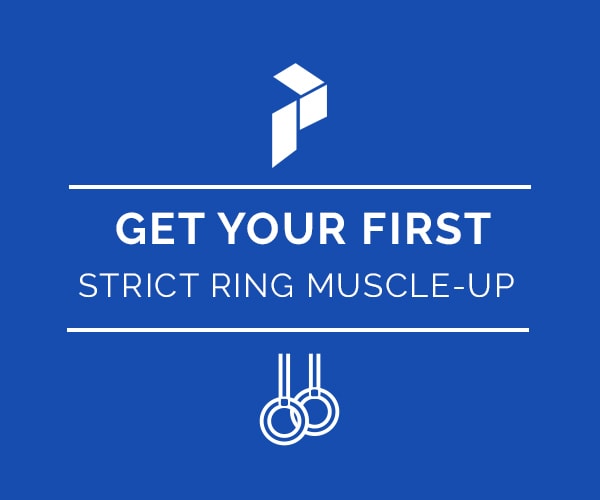Frustrated with Strict Ring Muscle-Ups?
Let’s drastically improve this skill!
Don’t worry, this strength skill takes a lot of time and practice but is definitely worth the hard work because it has a lot of benefits as a strength training skill. Those who train the strict ring muscle-up will build grip strength, pulling strength, tricep strength, and body awareness. Along with those benefits, any training on the ring apparatus requires a tremendous amount of stability and strength and can benefit you in handstands, weightlifting, and even more sport-specific events.
Before we dive into a few excellent tips to help your strict muscle-up, you should check out our Strict Ring Muscle-Up program. We have had thousands of athletes build their strength and skills with muscle-ups following this 5-week plan!
We must first look at the strict ring muscle-up so we understand the 3 phases of the skill; the pull, the transition, and the dip to support.
So where does one begin to build a Ring Muscle-Up foundation? We will run you through some steps to help you understand the evolution of this skill.
THE FALSE GRIP IN THE STRICT RING MUSCLE-UP
First, you will need to understand the “false grip” and how you can gain strength in the false grip. You need to know that this is not a comfortable grip and for many it can be painful because it may use grip and forearm muscles you are not used to. It is imperative to gain strength in this grip because it is necessary to go from the pull to the press in the strict ring muscle-up. You will eventually build up calluses on your wrists and it won’t be so uncomfortable, after a while.
This video explains a bit about the false grip and why it is important to this skill.
THE PULL
Then, you will need pulling strength, and a tremendous amount of it because you will need to pull below your armpit in order to successfully transition into the dip portion of the ring muscle-up. You can train pulling strength on both the rig and rings. On the rig, you can work on chin up pulls to the chest and on the rings you can work on false grip pulls to sternum [or as low as you can pull].
THE TRANSITION
The transition is key to getting you from below the rings to above the rings, and for many, the most difficult portion of the skill. Most make the mistake of forgetting to continue pulling or pressing during the transition, so they end up falling “through” the rings because gravity wins! Some key points to remember when training this portion; First, think of yourself as riding the elevator up the entire skill so you continually do “work.” Next, think about fast elbows so you can move from a pull position to a press position. If the elbows never move up then your hands will not be able to press down to support your weight. Lastly, think about pulling into a deeper hollow as you move through the transition. When you pull the rib down, it automatically forces the elbows to move into that upward position.
Here are two drills to help with the transition.
THE DIP
The dip is the final phase of this skill and there is nothing more frustrating than completing the pull and transition and having no strength left to finish the dip into the final support position. The dip is mainly a tricep strength exercise and strength needs to be gained in sequence from tricep pushups on the floor to static dips off boxes or parallel bars and then finally ring dips. If you train this skill out of foundational sequence, it will most likely take you a lot longer to master.
The dip also requires a significant amount of shoulder mobility. This article discusses further.
Here are some key points for the ring dip.
The strict ring muscle-up takes time and dedication but will have many benefits to your training and it should be celebrated when achieved!f
Want to learn more?
Written by Pamela Gagnon







